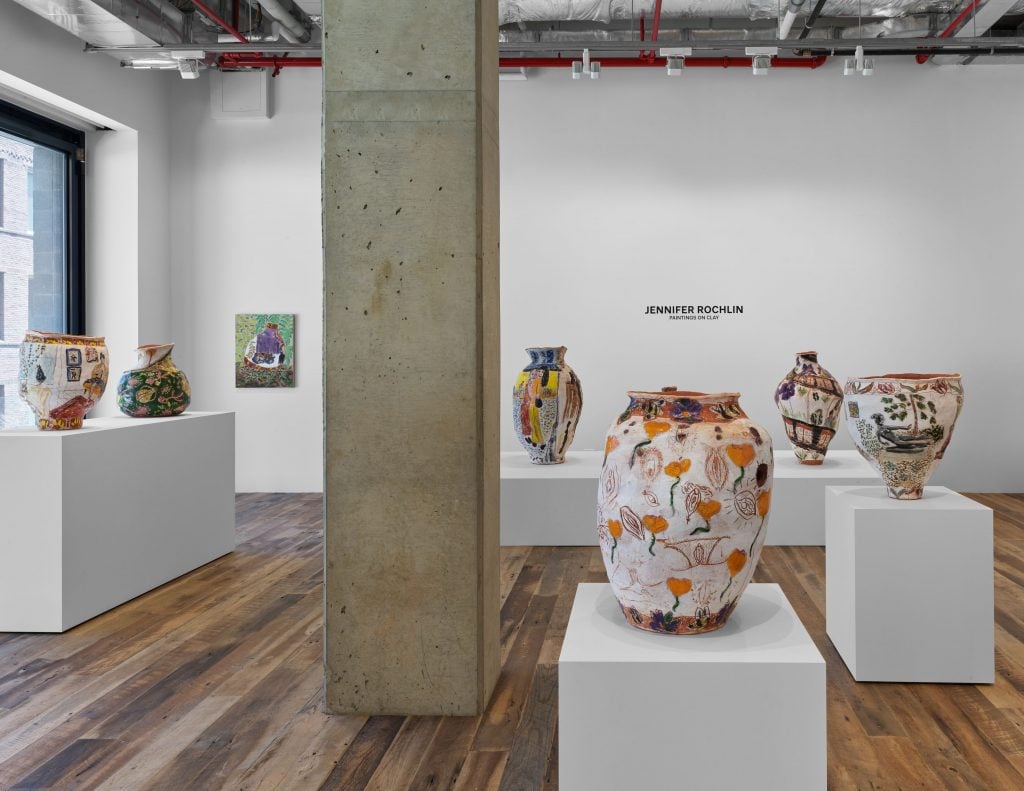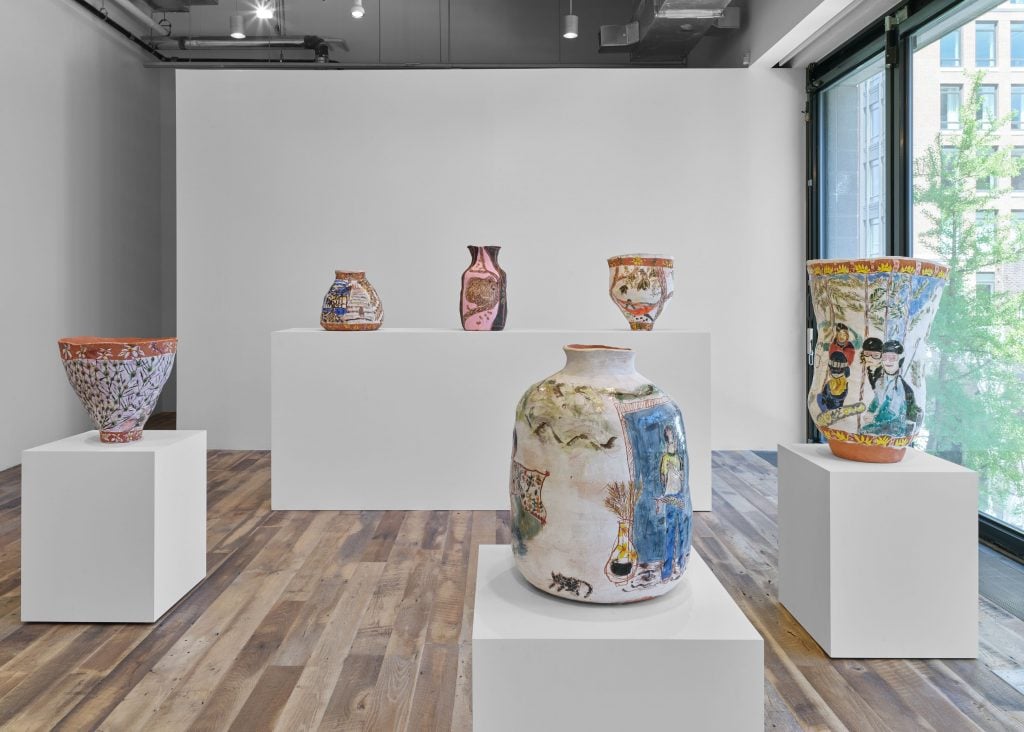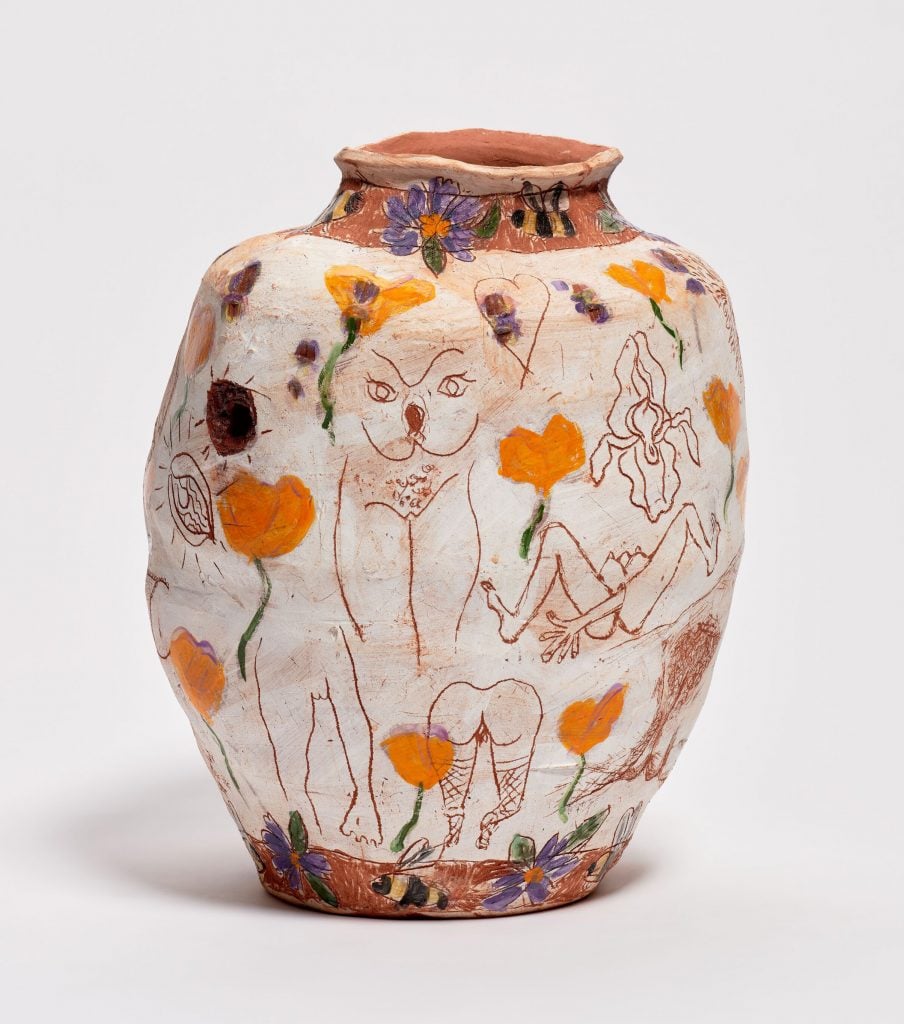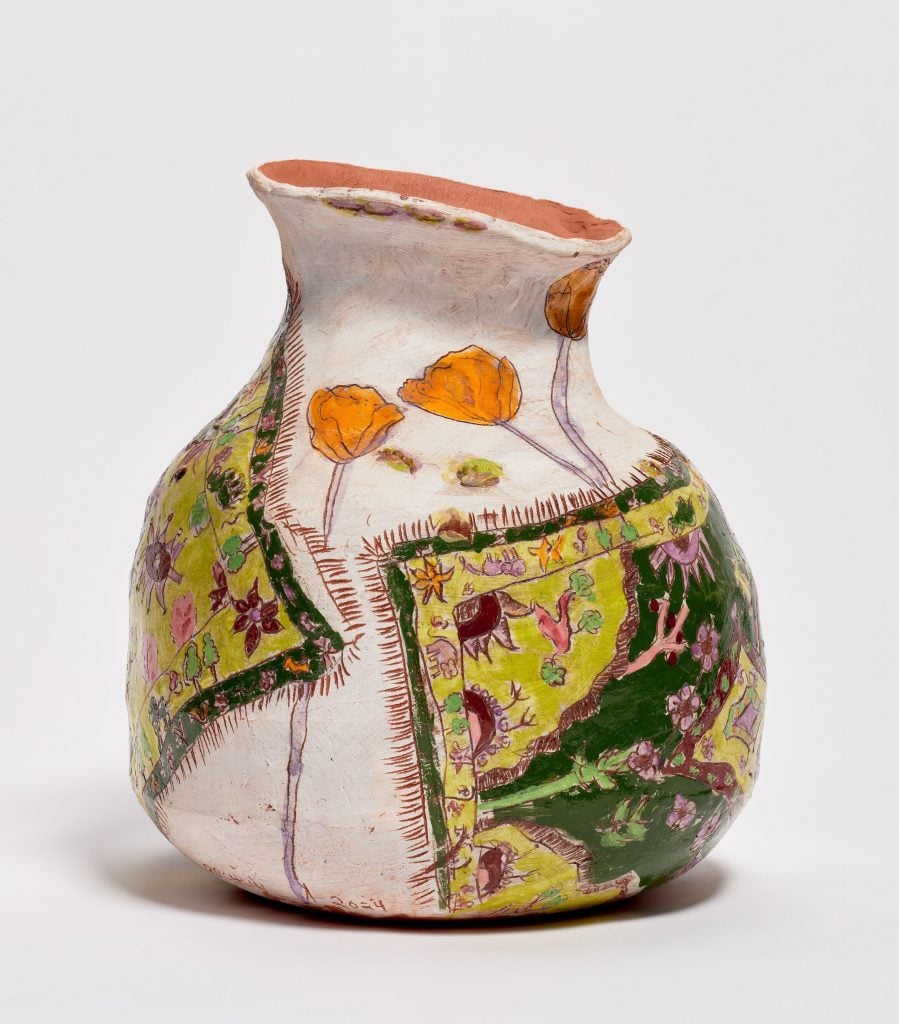Art & Exhibitions
Jennifer Rochlin’s Quirky Vessels Give Form to Fleeting Memories
New York solo exhibition "Paintings on Clay" is Rochlin's first with Hauser and Wirth, on view through July 14.

New York solo exhibition "Paintings on Clay" is Rochlin's first with Hauser and Wirth, on view through July 14.

Annikka Olsen

Jennifer Rochlin’s large, hand-formed terracotta vessels seemingly compel viewers to get up close and personal and take a closer look—a phenomenon no more apparent than in her current solo show, “Paintings on Clay,” at Hauser and Wirth in New York, on view through July 14, 2024. Presented across a range of pedestals and plinths, the exhibition invites visitors to move between, circumvent, and even peer inside the various pots, exploring their painted and etched patterns, vignettes, and, most intriguingly, storylines.

Installation view of “Jennifer Rochlin: Paintings on Clay” (2024). Photo: Sarah Muehlbauer. Courtesy of the artist and Hauser and Wirth.
While the tradition of ceramics may call to mind visions of highly polished and evenly proportioned pots and containers, Rochlin relishes in the idiosyncrasies of intuitive form and shape as it directly reflects the hand of the artist and provides a unique starting point for her subsequent paintings and drawings.
“I did once make a very perfect pot” said Rochlin on a video call from her home in Altadena, California. “I just found it boring, I was like, ‘where’s my way in here’? When I was going to paint and draw, it was just so perfect that I wasn’t interested in it. I think the slumps and the lumps and the molding and the disfigurement, that to me is something that I find aesthetically interesting.”

Installation view of “Jennifer Rochlin: Paintings on Clay” (2024). Photo: Sarah Muehlbauer. Courtesy of the artist and Hauser and Wirth.
Rochlin came to ceramics nearly two decades ago, and the medium ultimately became the artist’s “canvas” of choice for her paintings. The shape of each vessel is arrived at intuitively, shaping and fashioning the clay in a manner that its structural integrity stays true but doesn’t adhere to a prescribed form. It is only once the pot is finished that Rochhlin considers what will go on it, with the shape typically informing the rest of the design of the piece.
The images Rochlin chooses to adorn each vessel with are arrived at in a similar manner: intuitively and based on her present thoughts or emotions. Echoing Surrealist automatism, wherein the artist attempts to let the unconscious come to the fore over conscious control, Rochlin’s memories and imaginings can be traced across the surface of each work.

Jennifer Rochlin, Trans-Siberian Railway (2023). Photo: Keith Lubow. Courtesy of the artist and Hauser and Wirth.
A highlight of the show, Trans-Siberian Railway (2023), features a spiraling train surrounded by larger-than-life irises, drawn from Rochlin’s memory of travelling along the Trans-Siberian Railroad in Russia, which she captured on Super 8 film, with the composition alluding to the way in which a roll of film unravels. By one illustrated train car, a man has picked some of the irises and offers them to a woman in one of the train’s windows. In reality, it was a scene of two strangers, within Rochlin’s depiction, the woman is a self-portrait of the artist herself.
“What’s funny is when I was drawing it, it was completely unconscious that [the subject] became me—it wasn’t,” Rochlin described. “I was in my mind drawing the image that I had from the Super 8 film, which I haven’t looked at in I don’t even know how long. It was a memory of that Super 8. I think it was because I was feeling this longing for a romance at the time that I made the work. I wanted to do this quintessential romantic gesture. The idea that the flowers be thrown up, then the train takes off, and they never see each other again.”

Jennifer Rochlin, Honey Pot (2024). Photo: Keith Lubow. Courtesy of the artist and Hauser and Wirth.
Another central work in the show highlights Rochlin’s penchant for collaboration and sharing the experience of making her vessels, Honey Pot (2024). Across its surface are drawings of female genitalia by 22 women artists. Some of the drawings were done very spur of the moment, as Rochlin notably loaded the piece in the back of her car, double parked outside of a gallery opening, and invited several artists out to make their contribution. Others made their additions on studio visits or sent digital drawings to be transferred on.
Rochlin said, “When I started having artists draw on the pots with the collaborative pieces, then I have all these kind of random drawings—how am I unifying them? I like that it’s like a community, and I love how the act of just scratching into the clay is so pleasurable, I want to share that with people.”

Jennifer Rochlin, Green Tapestry with Poppies and Bites (2024). Photo: Keith Lubow. Courtesy of the artist and Hauser and Wirth.
Other pieces on view, such as Green Tapestry with Poppies and Bites (2024), shows another hallmark form of Rochlin’s collaboration, as visitors to the studio have been given the opportunity to physically bite into the clay leaving teeth marks as unique as fingerprints. It also further taps into the process of remembering, as the tapestries and poppies, untethered from a narrative or landscape, float across the surface like fragmented memories. Although every work is rooted into Rochlin’s own deeply personal life and history, throughout is an undercurrent of universality and collective experience.
“I think since my work is unfiltered and honest, and you can feel the emotion through the mark making, I think that people can relate to it and have it brings up memories for them and they can have a shared memory of a lost love, or your children growing up, or in time passing. That’s what I’m hoping that viewers are experiencing and it’s going to connect with them on a deep level of their own.”

Jennifer Rochlin, Ladies at the Norton Simon Museum (2023). Photo: Keith Lubow. Courtesy of the artist and Hauser and Wirth.
Beyond the psychological rawness of Rochlin’s work, the rawness of the base material itself too is stark. When looking closely at each vessel, the imperfect edges and unpainted clay peeking out imbues each piece with an air of the ancient, even primordial, a glimpse at what an artifact from today might look like far into the future. Recalling Athenian narrative pottery in the arrangement of scenes and decorative elements, both the collaborative works and pieces completed by Rochlin alone speak to collective experiences as well as the deeply individual and personal.
“I’m working in a tradition that has such a long lineage of storytelling and I really love getting to be an active participant and continue this tradition. Making and telling a story on a vessel started thousands of years ago, and that’s still relevant in our day and age. With A.I. and Instagram and all the phones and everything, I think the more handmade the better. The more you get to see something that is just made of dirt, water, and fire, it just stands the test of time. And I’m happy that people are interested in that still.”